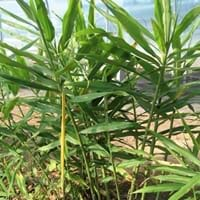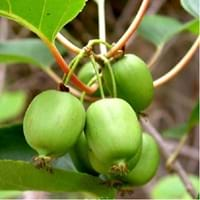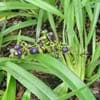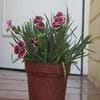Life Span
Annual
Perennial
Type
Tender Perennial
Fruit
Origin
Southern Asia, India, China, Melanesia, Micronesia, Australia
Eastern Asia
Types
Not Available
Actinidia arguta, Actinidia giraldii, Actinidia hypoleuca
Habitat
agricultural areas, Moist Soils, Warmer regions
Dappled Shade, open Woodlands
USDA Hardiness Zone
Not Available
3-8
AHS Heat Zone
Not Available
8-1
Sunset Zone
Not Available
1a, 1b, 2a, 2b, 3a, 3b, 4, 5, 6, 7, 8, 9, 14, 15, 16, 17, 18, 19, 20
Habit
Clump-Forming
Vining/Climbing
Flower Color
White, Red, Green, Orange, Pink, Magenta, Fuchsia, Rose, Lavender
White, Ivory
Flower Color Modifier
Bicolor
Bicolor
Fruit Color
Not Available
Green, Yellow green
Leaf Color in Spring
Green, Dark Green
Green, Dark Green
Leaf Color in Summer
Green, Dark Green
Dark Green
Leaf Color in Fall
Green, Dark Green
Dark Green
Leaf Color in Winter
Light Green
Light Green
Plant Season
Not Available
Spring, Summer, Fall
Sunlight
Partial Sun
Full Sun, Partial Sun
Growth Rate
Medium
Medium
Type of Soil
Not Available
Loam
The pH of Soil
Not Available
Neutral
Soil Drainage
Moist
Well drained
Bloom Time
Indeterminate
Spring, Late Spring, Early Summer
Repeat Bloomer
Not Available
No
Tolerances
Drought
Shade areas
Where to Plant?
Container, Ground
Ground, Pot
How to Plant?
From Rhizomes
Grafting, Stem Cutting
Plant Maintenance
Medium
Low
Watering Requirements
Do Not over Water, Keep ground moist
Average Water Needs, Requires regular watering
In Summer
Adequately
Regular watering required
In Spring
Moderate
Moderate
In Winter
Less Watering
Average Water
Soil pH
Not Available
Neutral
Soil Type
Not Available
Loam
Soil Drainage Capacity
Not Available
Well drained
Sun Exposure
Partial Sun
Full Sun, Partial Sun
Pruning
Remove damaged leaves, Remove dead branches, Remove dead leaves
Remove damaged leaves, Remove dead branches, Remove dead leaves
Fertilizers
All-Purpose Liquid Fertilizer
Apply 10-10-10 amount, fertilize twice a year
Pests and Diseases
Bacteria wilt, Bacterial Blight, Rhizome rot, Root knot nematode
Botrytis head rot, Japanese Beetles, Leaf Rollers, Nematodes, Phytophthora, Root rot, Sclerotinia blight, Spider mites, Thripes
Plant Tolerance
Drought
Shade areas
Flower Petal Number
Single
Single
Fragrant Fruit
Not Available
Yes
Fragrant Leaf
Not Available
No
Fragrant Bark/Stem
Not Available
No
Foliage Texture
Not Available
Medium
Foliage Sheen
Not Available
Glossy
Self-Sowing
Not Available
No
Attracts
Butterflies, Flying insects
Cats
Allergy
Heartburn, Stomach burn
Not Available
Aesthetic Uses
Beautification, Ground Cover
Cottage Garden
Beauty Benefits
Acne, For treating wrinkles, Nourishes scalp, Speed hair growth
Not Available
Environmental Uses
Indoor Air Purification, Provides ground cover, soil stabilisation
Shadow Tree
Medicinal Uses
Cold, Dysentry, High cholestrol, Rheumatoid arthritis, Skin Disorders, Treat Parasitic Intestinal Worms, Weight management and satiety
Antioxidants, Fiber, Folate, Rich in Potassium, Vitamin C
Part of Plant Used
Leaves, Rhizomes
Fruits
Other Uses
Can be made into a herbal tea, Cosmetics, Oil is used in perfume, soaps, creams, etc., Used as Ornamental plant, Used as a spice
Grown for shade
Used As Indoor Plant
Yes
No
Used As Outdoor Plant
Yes
Yes
Garden Design
Container, Cutflower, Houseplant, Tropical
Edible, Feature Plant, Vine
Botanical Name
CURCUMA
ACTINIDIA arguta
Common Name
Ginger
Hardy Kiwi
In Hindi
अदरक
हार्डी कीवी
In German
Ingwer
Hardy Kiwi
In French
Gingembre
kiwai
In Spanish
Jengibre
kiwi hardy
In Greek
Τζίντζερ
σκληραγωγημένα ακτινίδια
In Portuguese
Gengibre
kiwi Hardy
In Polish
Imbir
hardy kiwi
In Latin
gingiber
Hardy kiwi
Phylum
Magnoliophyta
Magnoliophyta
Class
Liliopsida
Magnoliopsida
Order
Zingiberales
Theales
Family
Zingiberaceae
Actinidiaceae
Genus
Zingiber Mill.
Actinidia
Clade
Angiosperms, Commelinids, Monocots
Angiosperms, Asterids, Eudicots
Tribe
Not Available
Not Available
Subfamily
Not Available
Actinidiaceae
Number of Species
Not Available
Not Available
Season and Care of Ginger Plant and Hardy Kiwi
Season and care of Ginger Plant and Hardy Kiwi is important to know. While considering everything about Ginger Plant and Hardy Kiwi Care, growing season is an essential factor. Ginger Plant season is Not Available and Hardy Kiwi season is Not Available. The type of soil for Ginger Plant is Not Available and for Hardy Kiwi is Loam while the PH of soil for Ginger Plant is Not Available and for Hardy Kiwi is Neutral.
Ginger Plant and Hardy Kiwi Physical Information
Ginger Plant and Hardy Kiwi physical information is very important for comparison. Ginger Plant height is 200.00 cm and width 1,500.00 cm whereas Hardy Kiwi height is 550.00 cm and width 90.00 cm. The color specification of Ginger Plant and Hardy Kiwi are as follows:
Ginger Plant flower color: White, Red, Green, Orange, Pink, Magenta, Fuchsia, Rose and Lavender
Ginger Plant leaf color: Green and Dark Green
Hardy Kiwi flower color: White and Ivory
- Hardy Kiwi leaf color: Green and Dark Green
Care of Ginger Plant and Hardy Kiwi
Care of Ginger Plant and Hardy Kiwi include pruning, fertilizers, watering etc. Ginger Plant pruning is done Remove damaged leaves, Remove dead branches and Remove dead leaves and Hardy Kiwi pruning is done Remove damaged leaves, Remove dead branches and Remove dead leaves. In summer Ginger Plant needs Adequately and in winter, it needs Less Watering. Whereas, in summer Hardy Kiwi needs Regular watering required and in winter, it needs Average Water.





